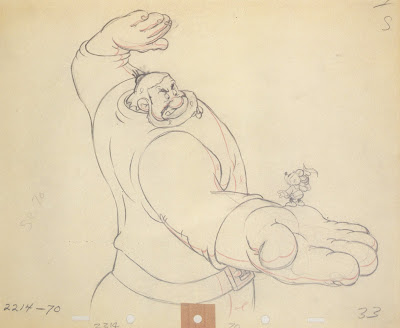You really can't overstate the inventive animation Bill Tytla produced during his time at Disney.
Just take his work on the Giant from the 1938 short The Brave Little Tailer. On the surface his design is pretty cartoony. Around this time Giant personality types similar to this one showed up in short films from other studios. But Tytla's animation shines because on top of basic animatable forms he applies real human anatomy. Each hand, leg or foot is a study in a classical sense. The way finger- and toenails are drawn in proper perspective shows that this man was a master artist who knew the human figure.
And then there is this tremendous feeling of weight in the animation. WEIGHT !! One of the most important components in any kind of animation.
These clean up lines were drawn over Tytla's rough animation, on the same sheet of paper. That's why the drawings have such vitality as well as beautiful dimensional volumes. Groundbreaking work.
Are young animation students today still studying this kind of stuff? I sure hope so.








That whole short is so great, and this is a perfect example of knowing the rules, then bending them! The anatomy is great, but it's made a little squashier wherever it suits. The perspective is pushed, etc.
ReplyDeleteThough I also like the squashy Giant character that's in Fun and Fancy Free, and Mickey's Christmas Carol
Nothing beats solid foundations and anatomy training that's for sure.
ReplyDeleteThank you for this post! :)
ReplyDeleteI'm glad that „The Brave Little Taylor“ is one part of my „Sword in the Stone“ DVD. I'm a fan of great animated-short-films. :) ...
Since I read this post I thought a lot about what I miss when I see pictures like Camille Bombois „The Athlete“ from 1930 or Fernando Boteros „Dancers at the Bar“ from 2001...
I have a big art book about „Michelangelo“ with 300 great black and white images. This book appeared in 1953 by „Phaidon“.
It is my gold-mine! :)
To take part in life drawing courses is the best.
I think to study Michelangelos artwork by drawing can be helpful, too.
🤩
ReplyDelete